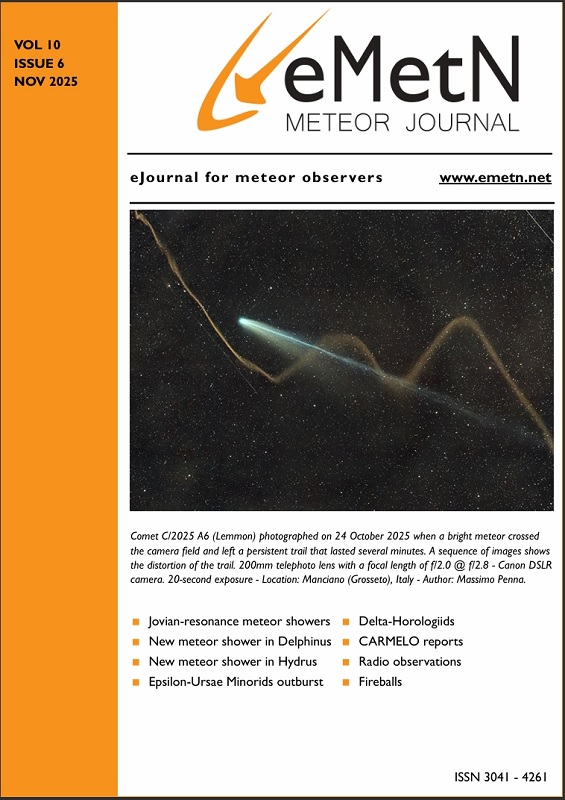Roberto Gorelli points our attention at a recently published meteor related paper.
The orbital clusters among the near Earth asteroids
This paper has been submitted for publication to the Monthly Notices of the Royal Astronomical Society by Tadeusz J. Jopek
Abstract: Fifteen orbital clusters (associations) were identified among ∼20000 near Earth asteroids (NEAs). All associations were found with a high statistical reliability, we used a single linkage cluster analysis algorithm and three orbital similarity functions. Identified groups are small fraction (4.74 %) of the whole sample. However they could be hazardous to the Earth and its inhabitants. Every year similarly as it happens with meteoroid streams, the Earth comes very close to the orbits of each association. In two cases (2008TC3 and 2017FU102) the distance between the asteroid orbit and the Earth’s orbit was smaller than the radius of our planet. Among members of the identified associations we found 331 objects larger than the Chelyabinsk asteroid and all these objects approach the Earth’s orbit at a distance smaller than 0.05 [au].
Two of the identified groups (4179) Toutatis and (251430) Itokawa, proved to be in favor of a catastrophic origin of Toutatis and Itokawa asteroids.
In this study we were not interested in the origin of the identified groups. However, regardless of their origin, in view of the serious thread to the Earth, tracing the NEA associations is very important issue. To facilitate their monitoring of we have calculated coordinates of the theoretical radiants and calendar date of their potential activity.
You can download this paper for free: https://arxiv.org/pdf/2001.08786.pdf (14 pages).
Older meteor library news:
2019
- Parker Solar Probe Observations of a Dust Trail in the Orbit of (3200) Phaethon, by Karl Battams, Matthew M. Knight, Michael S.P. Kelley, Brendan M. Gallagher, Russell A. Howard, and Guillermo Stenborg. (22 December 2019).
- Meteoroid Stream Formation Due to the Extraction of Space Resources from Asteroids, by Logan Fladeland, Aaron C. Boley, and Michael Byers. (2 December 2019).
- Estimating trajectories of meteors: an observational Monte Carlo approach – II. Results, by Denis Vida, Peter G. Brown, Margaret Campbell-Brown, Paul Wiegert and Peter S. Gural. (27 November 2019).
- Estimating trajectories of meteors: an observational Monte Carlo approach – I. Theory, by Denis Vida, Peter S. Gural, Peter G. Brown, Margaret Campbell-Brown and Paul Wiegert. (11 November 2019).
- Meteor shower activity profiles and the use of orbital dissimilarity (D) criteria, by Althea V. Moorhead. (25 October 2019).
- A fireball and potentially hazardous binary near-Earth asteroid (164121) 2003 YT1, by Toshihiro Kasuga, Mikiya Sato, Masayoshi Ueda, Yasunori Fujiwara, Chie Tsuchiya, and Jun-ichi Watanabe. (18 October 2019).
- Spectral and orbital survey of medium-sized meteoroids, by Pavol Matlovic, Juraj Tóth, Regina Rudawska, Leonard Kornoš and Adriana Pisarcíková. (7 August 2019).
- Rising from Ashes or Dying Flash? Mega Outburst of Small Comet 289P/Blanpain in 2013, by Quanzhi Ye (叶泉志) and David L. Clark. (19 June 2019).
- Discovery of a Meteor of Interstellar Origin, by Amir Siraj and Abraham Loeb. (10 June 2019).
- A Mathematical Model for Simulating Meteor Showers, by M. Cardinot and A. Namen. (4 June 2019).
- The 2019 Taurid resonant swarm: prospects for ground detection of small NEOs, by David Clark, Paul Wiegert and Peter G. Brown. (28 May 2019).
- Analysis of the June 2, 2016 bolide event over Arizona, by Csaba Palotai, Ramanakumar Sankar, Dwayne L. Free, J. Andreas Howell, Elena Botella and Daniel Batcheldor. (25 May 2019).
- Identifying Interstellar Objects Trapped in the Solar System through Their Orbital Parameters, by Amir Siraj and Abraham Loeb. (5 May 2019).
- Meteor Shower Modeling: Past and Future Draconid Outbursts, by A. Egal, P. Wiegert, P. G. Brown, D. E. Moser, M. Campbell-Brown, A. Moorhead, S. Ehlert and N. Moticska. (1 May 2019).
- Meteoroid structure and fragmentation, by M. D. Campbell-Brown. (24 March 2019).
- Solar cycle variation in radar meteor rates, by M. D. Campbell-Brown. (26 February 2019).
- A New Meteoroid Model, by Valeri V. Dikarev, Eberhard Grün, William J. Baggaley, David P. Galligan, Markus Landgraf, Rüdiger Jehn. (12 February 2019).
- Lunar impacts, by Costantino Sigismondi. (12 February 2019).
- Lunar impact flashes, by C. Avdellidou and J. Vaubaillon. (10 February 2019).
- The Geminid parent body: (3200) Phaethon, by Patrick A. Taylor, Edgard G. Rivera-Valentín, Lance A.M. Benner, Sean E. Marshall, Anne K. Virkki, Flaviane C.F. Venditti, Luisa F. Zambrano-Marin, Sriram S. Bhiravarasu, Betzaida Aponte-Hernandez, Carolina Rodriguez Sanchez-Vahamonde and Jon D. Giorgini. (10 February 2019).
- Sun approaching asteroids and meteor streams, by Quanzhi Ye and Mikael Granvik. (10 February 2019).
2018
- Waiting to make an impact: A probable excess of near-Earth asteroids in 2018 LA-like orbits, by C. de la Fuente Marcos and R. de la Fuente Marcos. (18 December 2018).
- What mechanisms dominate the activity of Geminid Parent (3200) Phaethon?, by LiangLiang Yu, Wing-Huen Ip and Tilman Spohn. (6 November 2018).
- The Draconid meteoroid stream 2018: prospects for satellite impact detection, by Auriane Egal, Paul Wiegert, Peter G. Brown, Danielle E. Moser, Althea V. Moorhead and William J. Cooke (21 September 2018).
- Modeling the measurement accuracy of pre-atmosphere velocities of meteoroids, by Denis Vida, Peter G. Brown and Margaret Campbell-Brown (15 July 2018).
2017
- The Mayas and Eta Aquariids in AD 250-909, by J.H. Kinsman and D.J. Asher (31 July 2017).





